
Aquamation or Flame Cremation? The Price Tag Showdown
Why Understanding Water Cremation Cost vs Cremation Matters for Your Facility
Water cremation cost vs cremation is one of the most important financial comparisons funeral directors face today. As more families seek eco-friendly alternatives, understanding the price differences helps you make informed equipment decisions and set appropriate service pricing.
Quick Cost Comparison:
- Water Cremation (Aquamation): $1,295-$4,600 (average $2,500)
- Traditional Cremation: $1,100-$2,000 (average $1,600)
- Traditional Burial: $7,000-$12,000 (average $7,848)
- Price Gap: Water cremation typically costs $500-$900 more than flame cremation
The numbers tell a clear story. Water cremation equipment costs $180,000-$270,000 compared to $130,000 for flame cremation units. But families increasingly view the premium as worthwhile - one funeral director described it as "putting grannie in a warm bath rather than a hot fire."
This price difference stems from several factors: higher equipment costs, limited facility availability, and growing demand from environmentally conscious families. Water cremation uses 90% less energy than traditional cremation and produces 20-30% more ashes for families.
As Mortuary Cooler from American Mortuary Coolers, I've helped funeral homes nationwide steer the financial and operational considerations of water cremation cost vs cremation equipment decisions. My experience with custom mortuary solutions gives me unique insight into how these cost factors impact your bottom line and service offerings.
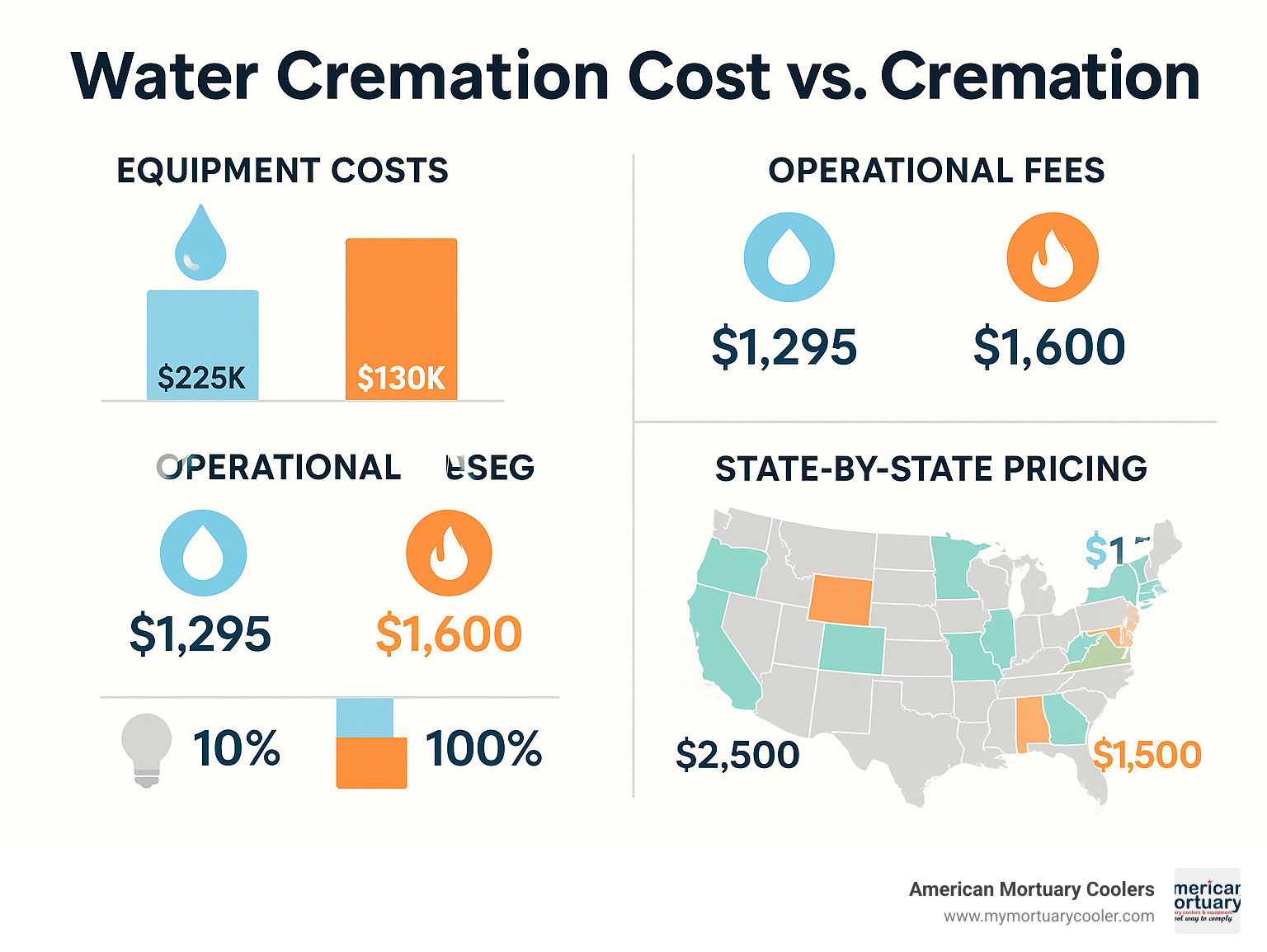
Relevant articles related to water cremation cost vs cremation:
- Eco-friendly funeral options
- how do you get cremated by water
- is water cremation legal in california
True Cost Showdown: Water Cremation Cost vs Cremation
Let's get real about the numbers. When families ask about water cremation cost vs cremation, they deserve straight answers without the sales pitch. The truth is, aquamation costs more upfront, but there's genuine value behind that price difference.
Here's what we're seeing across the country: water cremation typically runs $2,500 on average, while traditional flame cremation averages around $1,600. That's roughly $900 more for the water-based process. To put this in perspective, traditional burial still tops the charts at $7,848 on average, making both cremation options much more budget-friendly.
The price gap between water and flame cremation isn't arbitrary. Families choosing aquamation receive 20-30% more ashes compared to traditional cremation. The remains are also whiter and finer in texture, which many families find more appealing for keepsakes or scattering ceremonies.
| Service Type | Average Cost | Range | Key Benefits |
|---|---|---|---|
| Water Cremation | $2,500 | $1,295-$4,600 | More ashes, eco-friendly, gentler process |
| Flame Cremation | $1,600 | $1,100-$2,000 | Widely available, established process |
| Traditional Burial | $7,848 | $7,000-$12,000 | Traditional choice, permanent location |
Water Cremation Cost vs Cremation: National Averages at a Glance
The $2,500 average for aquamation reflects real market data from facilities nationwide. Most providers charge between $1,500 and $3,200, though you'll find outliers on both ends. Direct cremation services can start as low as $800 in competitive markets, while premium full-service options push higher.
What's driving that extra cost? Aquamation equipment runs $180,000 to $270,000 compared to traditional cremation units at around $130,000. Plus, the process takes 6-8 hours versus 2-3 hours for flame cremation, which affects facility scheduling and operational costs.
But families aren't just paying for equipment costs. They're investing in a process that uses 90% less energy than traditional cremation and produces zero direct emissions. Many describe the peace of mind as priceless, especially when environmental impact matters to their family values.
Water Cremation Cost vs Cremation: State-by-State Spread
Geography plays a huge role in pricing. Missouri leads the affordability charge at $995 for basic water cremation services. Meanwhile, California facilities start around $3,750, and Vermont tops out at $4,616 for aquamation services.
These price differences reflect local market realities. States with multiple aquamation providers see more competitive pricing. Areas with limited availability often charge premium rates, especially when families must transport remains across state lines.
Transport fees add another cost layer when local aquamation isn't available. Ohio families sometimes arrange services through Missouri providers, adding shipping and handling to the base price. Smart funeral directors are factoring these logistics into their service planning as demand grows.
The availability map is expanding rapidly. States that legalized aquamation recently are seeing new facilities come online, which should help moderate pricing over time. As we've seen with traditional cremation, increased competition typically brings costs down for families.
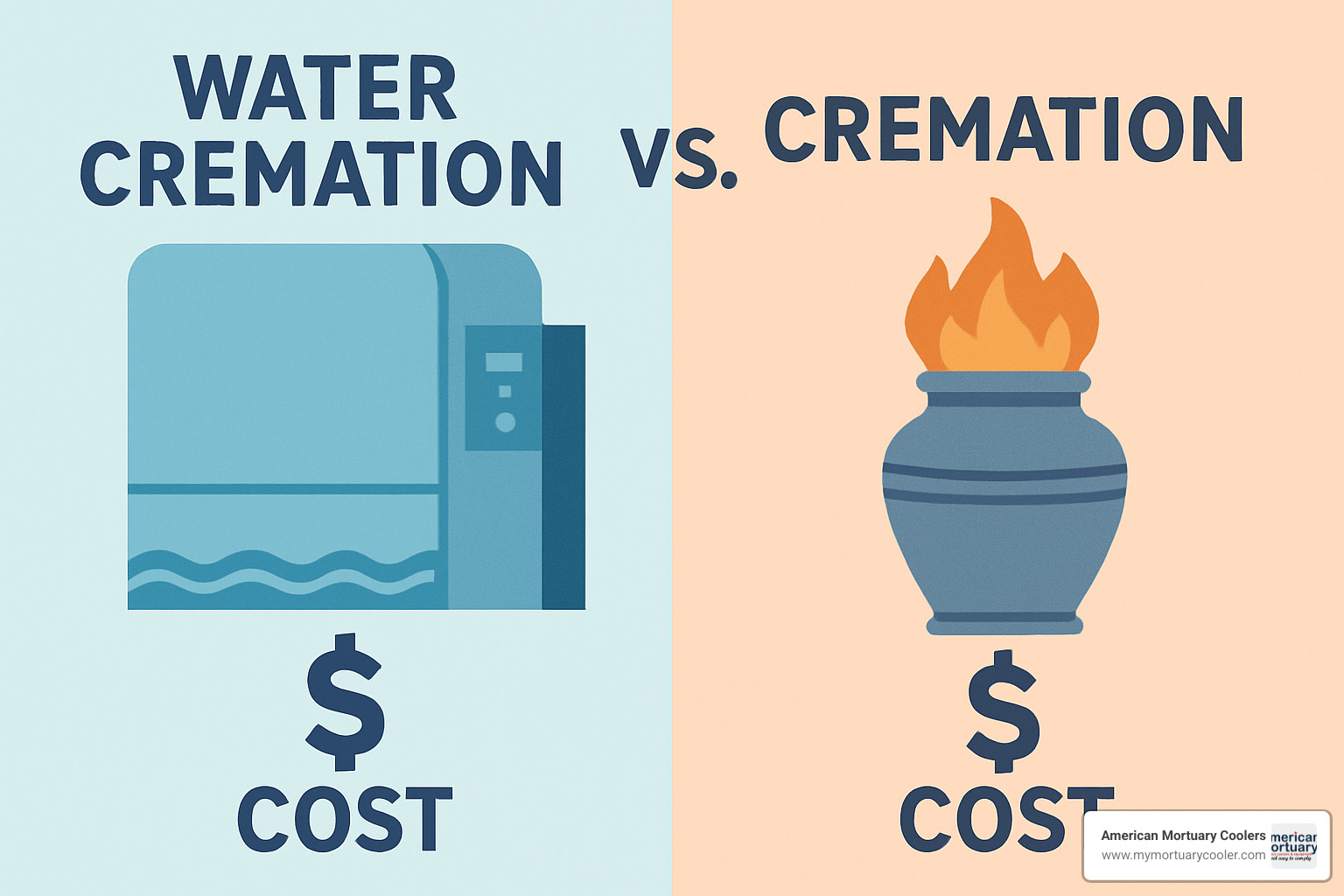
What Drives the Price Difference?
The water cremation cost vs cremation gap isn't arbitrary - it comes from real business factors that funeral directors face every day. When you dig into the numbers, the price difference starts making perfect sense.
The biggest factor? Equipment costs that'll make your accountant wince. Alkaline hydrolysis machines run between $180,000 and $270,000, while traditional cremation units cost around $130,000. That's nearly double the upfront investment before you even serve your first family.
But it's not just about buying the machine. You've got installation costs, specialized training for your staff, and regulatory compliance that varies wildly from state to state. Plus, when something breaks, you can't just call any repair technician – you need someone trained on alkaline hydrolysis equipment.
Here's where it gets interesting: water cremation uses only 10% of the energy that flame cremation requires. Sounds like a money-saver, right? Well, not exactly. The process takes 6-8 hours compared to 2 hours for traditional cremation, and those specialized machines need more maintenance. The energy savings help, but they don't eliminate the cost gap.
The limited availability creates a supply-and-demand situation that keeps prices liftd. Water cremation is legal in 28 states but only operational in 17. When families want this service and you're one of the few providers in town, basic economics work in your favor. For a deeper dive into these cost factors, check out our guide on Alkaline Hydrolysis vs Cremation: The Cost Winner Revealed.
Up-Front Provider Costs & Market Competition
Getting into the aquamation business requires serious commitment beyond just writing a check for equipment. Each state has different licensing requirements, and some require specific certifications for operators. Staff training isn't a weekend workshop – it's comprehensive education on chemical handling, safety protocols, and equipment operation.
The maintenance side tells another story entirely. Traditional cremation equipment has been around for decades, so finding qualified service technicians is relatively easy. With alkaline hydrolysis, you're dealing with newer technology and fewer experts. When your machine needs service, you might wait longer and pay more.
Market dynamics play a huge role too. Families choosing water cremation often prioritize environmental values over cost savings. They're typically willing to pay extra for what aligns with their beliefs – similar to how people pay premium prices for organic food or electric vehicles. This customer mindset allows providers to maintain higher pricing without losing business.
Competition remains limited in most markets. When you're the only aquamation provider within 100 miles, you're not competing on price the same way you would with traditional services. This situation benefits early adopters but will likely change as more facilities come online.
Hidden & Optional Fees to Watch
The base price comparison only tells part of the water cremation cost vs cremation story. Several additional fees can surprise families who aren't prepared for them.
Transportation costs hit hard when you're outside the standard service area. Most providers charge $2-4 per mile beyond their normal radius. If the nearest aquamation facility is 150 miles away, transportation alone could add $300-600 to the bill.
Timing affects costs too. Refrigeration storage runs $50-100 per day if processing gets delayed. Expedited service commands $200-500 premiums when families need faster turnaround. Some families want to witness the process beginning, which typically costs $100-300 for the service.
Don't forget the smaller fees that add up quickly. Death certificate copies cost $10-25 each, and most families need multiple copies for insurance, banks, and other administrative tasks. Premium urn upgrades can range from $50 to several hundred dollars, depending on materials and craftsmanship.
Can Insurance or Pre-Need Plans Help?
Good news: most life insurance policies cover water cremation costs without restrictions. Insurance companies typically don't limit how families use death benefits, so aquamation qualifies just like traditional disposition methods.
Final expense insurance designed specifically for funeral costs usually applies to water cremation services. These policies often provide $5,000-25,000 in coverage, which easily handles aquamation expenses in most markets.
Veterans benefits through the VA can help offset costs, though families should verify coverage details with their benefits coordinator. The standard $255 Social Security death benefit applies regardless of disposition method chosen.
Pre-need funeral plans require careful attention to contract language. Older plans written before water cremation became available might not specifically include this option. Some contracts need amendments or additional payments to cover the service. However, many providers offer payment plans and sliding scale pricing to make aquamation accessible for families with limited resources.
The key is having transparent conversations about all costs upfront. Families dealing with grief shouldn't face financial surprises during an already difficult time.
Beyond Dollars: Environmental & Emotional ROI
When families weigh water cremation cost vs cremation, they're often looking beyond the price tag to consider environmental impact and emotional comfort. For many, the extra $500-$900 represents an investment in values that matter deeply during their time of loss.
The environmental numbers tell a compelling story. Aquamation uses just 10% of the energy required for traditional cremation and produces a 75% lower carbon footprint. While one flame cremation can release around 880 pounds of CO₂ emissions into the atmosphere, aquamation eliminates these air emissions entirely.
The process also addresses concerns about mercury emissions from dental fillings - a real environmental issue with flame cremation. Metal implants like hip replacements stay intact and can be recycled rather than destroyed. For families who've spent their lives making eco-conscious choices, these benefits often justify the premium pricing. You can learn more about these environmental advantages in our article on Going Green with Water Cremation: An Eco-Friendly Farewell.
The emotional aspect runs just as deep. Many families describe the process as their loved one's "last act on the planet" - a final choice that reflects lifelong values about environmental stewardship.
Comparing Environmental Metrics Side-by-Side
The resource consumption differences between methods are striking. Traditional cremation burns through 92 cubic meters of natural gas compared to just 7 cubic meters for aquamation. Electricity usage drops from 29 kWh to 9 kWh - reductions that translate to real environmental impact.
Water usage often surprises people. Aquamation uses approximately 300 gallons - less than what an average household consumes in a single day. The sterile effluent can be safely returned to municipal water systems or even used as bio-nutrient fertilizer, completing a natural cycle that many families find meaningful.
Air quality represents another key difference. While flame cremation releases gases into the atmosphere, aquamation discharges only sterile water. This distinction matters especially for families concerned about air pollution and atmospheric health.
The scientific research backs up these environmental claims. Scientific research on cremation emissions shows measurable differences in environmental impact between the two methods.
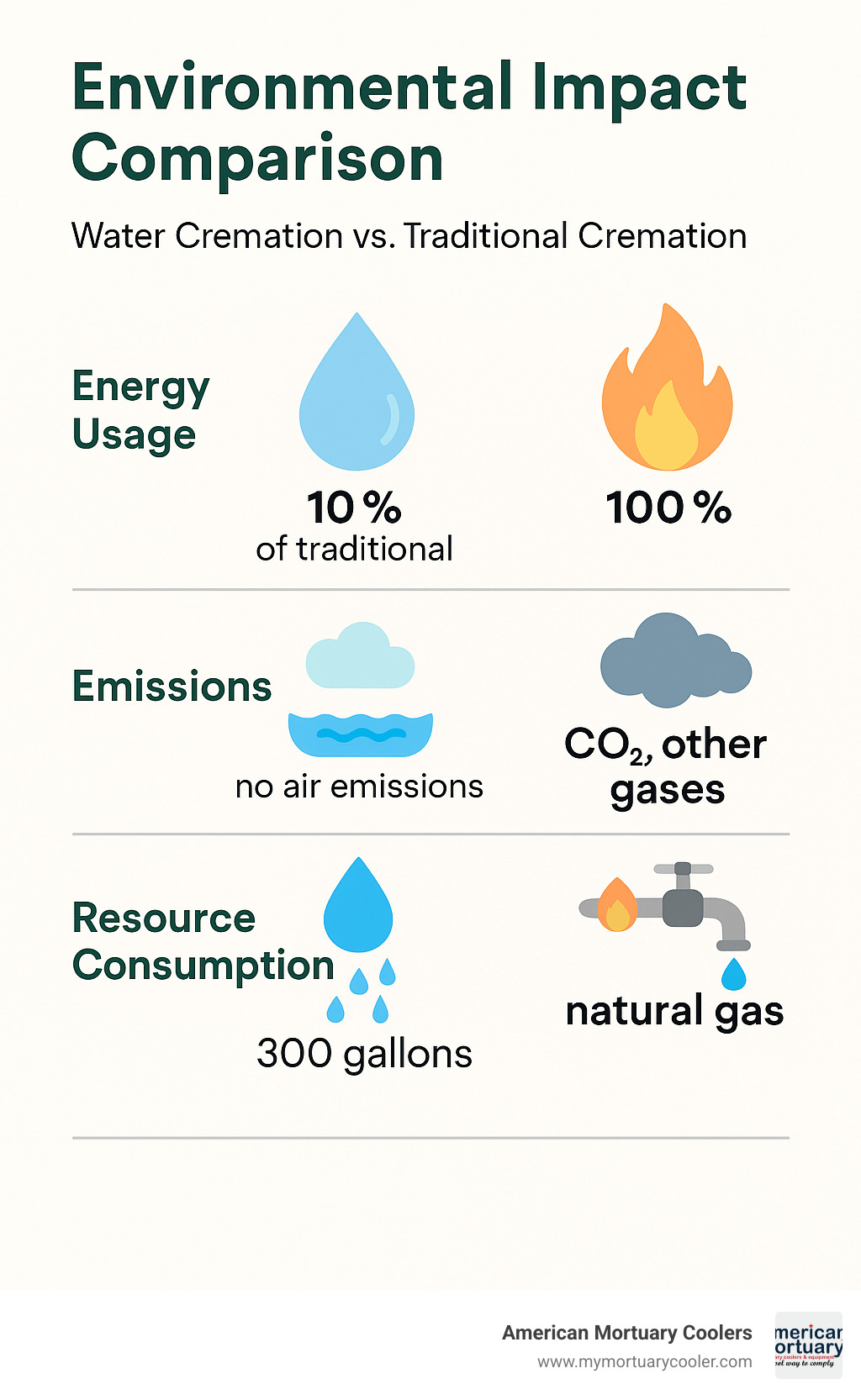
How Families Weigh Ecology, Faith, and Feelings
The decision often comes down to how the process feels to grieving families. Many find comfort in what one funeral director calls the "warm bath" analogy - the idea of their loved one being gently returned to nature through water rather than consumed by fire. This gentler image resonates powerfully during emotional decision-making.
Cultural acceptance varies widely across communities. While some initially view the process as unfamiliar, others immediately connect with the symbolism of water over flame. Religious leaders' opinions span the spectrum, though many note that if flame cremation aligns with their faith, water cremation should be equally acceptable.
The green burial movement has helped normalize alternative disposition methods, making families more open to considering aquamation. Environmental consciousness that guided life choices often extends to death care decisions, with families viewing the extra cost as worthwhile for staying true to their values.
The practical benefits add emotional value too. Families receive 20-30% more ashes than with flame cremation, providing more material for memorialization. The ashes are also whiter and finer in texture. This increased volume means families can divide remains among multiple family members, create various memorial items, and still have ashes for scattering or burial - options that bring comfort during the grieving process.
How to Save Money & Still Match Your Values
Finding ways to reduce water cremation cost vs cremation expenses doesn't mean compromising your environmental values. With some smart planning and research, families can access eco-friendly aquamation services without breaking the bank.
Regional price shopping often reveals surprising savings opportunities. We've seen families save over $1,000 by looking beyond their immediate area. Ohio residents, for example, sometimes arrange services through Missouri providers where aquamation costs $995 compared to $3,000+ locally. Even with transportation fees, the total cost remains significantly lower.
Pre-planning locks in today's rates and protects against future price increases. Many providers offer payment plans that spread costs over time, making the service more manageable financially. Some facilities provide sliding scale pricing for families facing financial hardship - it never hurts to ask about available assistance programs.
Veterans and their families should explore all available benefits. While the VA's basic death benefit is modest at $255, some veterans may qualify for additional assistance through state programs or veteran service organizations.
DIY & Minimalist Memorial Ideas
The memorial service itself offers numerous opportunities to save money while creating meaningful experiences. Home vigils allow families to gather in familiar, comfortable surroundings without venue rental fees. These intimate gatherings often feel more personal than formal funeral home services.
Virtual memorial services have become increasingly popular, especially for families spread across the country. Video platforms eliminate travel costs while allowing distant relatives to participate meaningfully. Many families combine small in-person gatherings with online streaming for the best of both worlds.
Biodegradable urns cost significantly less than premium options while supporting your environmental values. Simple cardboard or bamboo urns start around $25-50, compared to hundreds for elaborate designs. Scattering permits typically cost under $50 and allow families to return remains to meaningful outdoor locations.
Living urns that grow trees or plants provide ongoing memorial connections for $100-200. These bio-urns transform ashes into new life, creating a beautiful symbol of continuity. Memorial jewelry crafted from small portions of ashes preserves memories while leaving the majority of remains for other purposes.
Pet Aquamation vs Human Costs
Pet aquamation makes eco-friendly disposition much more accessible for beloved animal companions. Costs typically range from $25-150 for small animals, $150-350 for medium pets, and $350-500 for large animals - a fraction of human service pricing.
Many veterinary clinics now offer aquamation directly, simplifying the process during an already difficult time. Some providers offer combo packages for families planning both pet and human aquamation services, providing modest discounts for multiple services.
The emotional value often exceeds the cost difference. Pet owners who've chosen aquamation frequently describe feeling better about their environmental impact, even during grief. The process feels gentler and more natural than traditional cremation methods.
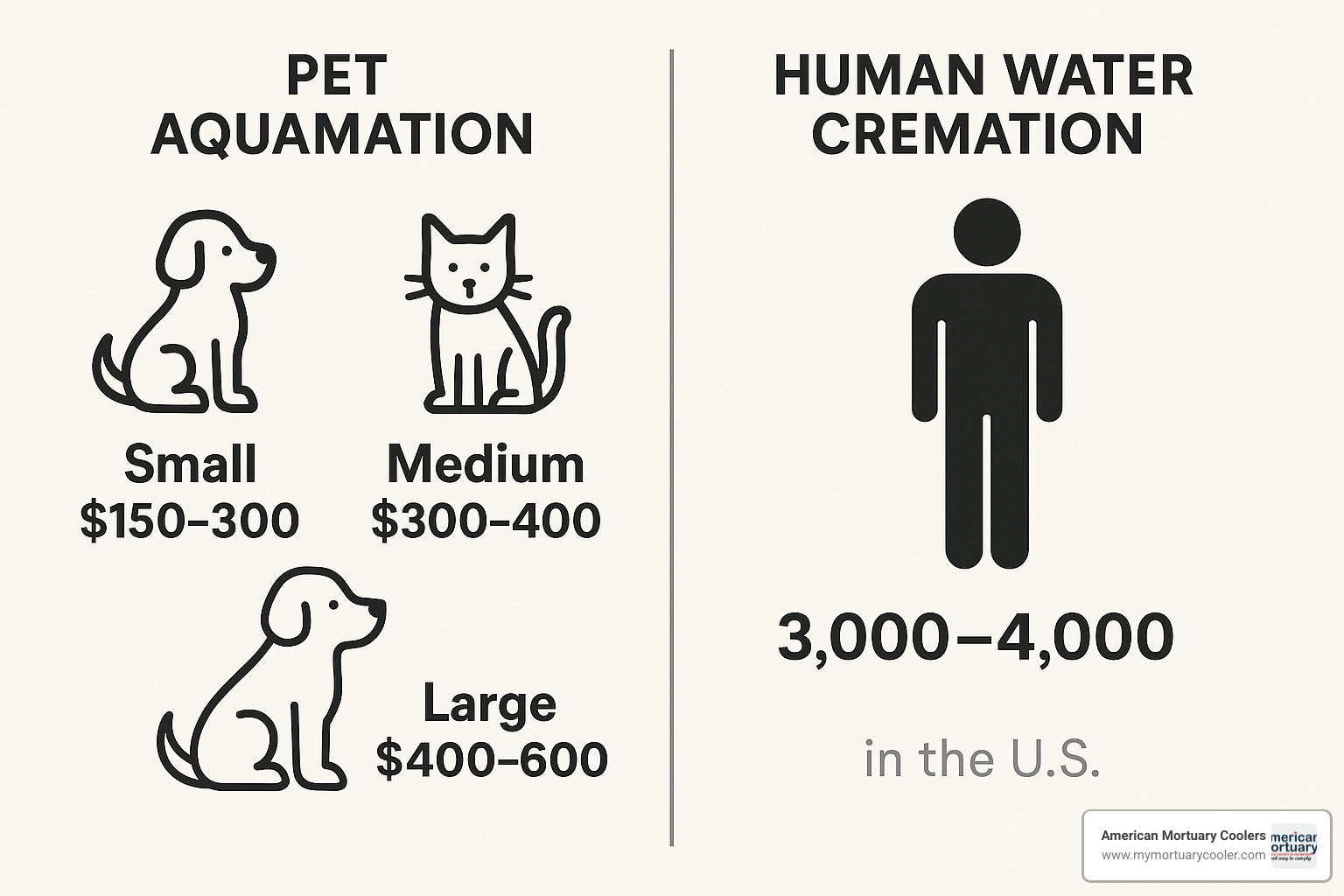
Frequently Asked Questions about Water Cremation Cost vs Cremation
When families start exploring their options, these are the questions that come up most often about water cremation cost vs cremation. Understanding the answers helps both funeral directors and families make informed decisions during difficult times.
Is water cremation legal in my state and how does that affect cost?
The legal landscape for water cremation continues to evolve, with 28 states currently allowing the practice as of 2025. However, here's where things get tricky – only 17 states actually have operational facilities running aquamation services.
This gap between legal permission and actual availability creates real challenges for families. You might live in a state where water cremation is perfectly legal, but find yourself needing to transport your loved one to a neighboring state for the service. Those transportation costs can add $2-4 per mile to your total expenses.
States with limited providers often charge premium prices simply because there's less competition. When only one or two facilities serve an entire region, market forces that typically keep prices reasonable just aren't there. We've seen this play out in places like Vermont, where costs can reach $4,616 compared to Missouri's low of $995.
Why is water cremation usually $500–$900 more than flame cremation?
The price difference boils down to several practical factors that affect every provider's bottom line. Equipment costs represent the biggest hurdle – aquamation machines run between $180,000 and $270,000 compared to roughly $130,000 for traditional cremation units.
Processing time also impacts pricing. Water cremation takes 6-8 hours versus just 2 hours for flame cremation. That's three to four times longer, which means facilities can handle fewer cases per day. The specialized maintenance requirements and training needs add to operational costs.
But there's a market factor at play too. Families choosing aquamation often prioritize environmental values and are willing to pay extra for those benefits. It's similar to how people pay more for organic food or electric vehicles – the premium reflects both higher costs and values-based purchasing decisions.
The limited number of facilities nationwide also supports higher pricing. When supply is restricted and demand is growing, prices naturally stay liftd. As more facilities come online, we may see this gap narrow.
Do the ashes look or feel different after aquamation?
Yes, and most families find the differences meaningful. Aquamation produces whiter, finer, and more uniform ashes compared to the grayer, sand-like texture you get from flame cremation. Many families describe the aquamation ashes as softer and more powder-like.
You'll also receive 20-30% more ash volume from water cremation. This extra quantity gives families more options for memorialization – whether that's dividing remains among family members, creating memorial jewelry, or having more for scattering ceremonies.
The ashes are completely sterile and safe for handling, just like traditional cremation remains. They work equally well for scattering, burial, or incorporation into memorial items like glass art or living urns. The main difference is the color and texture, which many families prefer for its gentler appearance.
Conclusion
When families weigh water cremation cost vs cremation options, they're making more than just a financial decision. Yes, aquamation typically costs $500-900 more than traditional flame cremation. But for many families, that premium buys peace of mind, environmental responsibility, and a gentler farewell that aligns with their values.
The numbers we've explored throughout this guide tell an interesting story. While water cremation represents a significant investment compared to traditional methods, it's still far less expensive than conventional burial. More importantly, families receive tangible benefits: 20-30% more ashes, dramatically reduced environmental impact, and the comfort of choosing what many describe as a more natural process.
Looking ahead, the funeral industry is clearly moving toward more sustainable practices. As more states legalize water cremation and additional facilities come online, we expect to see increased availability and more competitive pricing. Early adopters are currently paying premium rates, but expanding access should help moderate costs over the next decade.
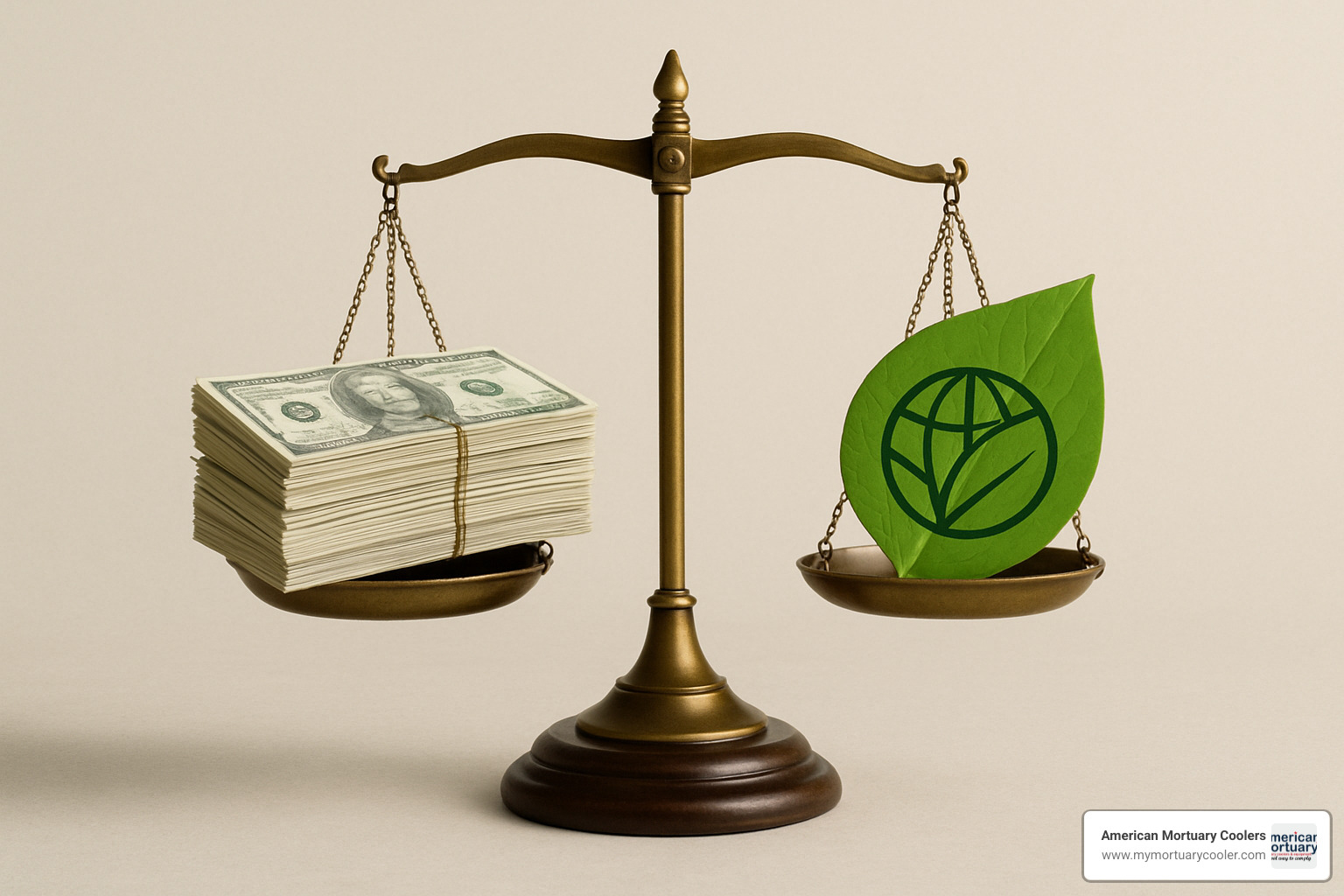
At American Mortuary Coolers, we've helped funeral homes from Tennessee to California, Chicago to Dallas steer these equipment decisions with custom mortuary solutions that meet their communities' evolving needs. Our direct delivery across all 48 contiguous states means you can access the right equipment to serve families seeking eco-friendly options.
The future looks promising for families wanting environmentally conscious disposition choices. Market forces will likely drive costs down as competition increases, while growing cultural acceptance makes water cremation a mainstream option rather than a niche service.
For funeral directors considering this investment, you're not just buying equipment - you're positioning your facility to serve the growing number of families who prioritize environmental stewardship in their final arrangements. The initial cost premium often pays dividends through increased service differentiation and customer satisfaction.
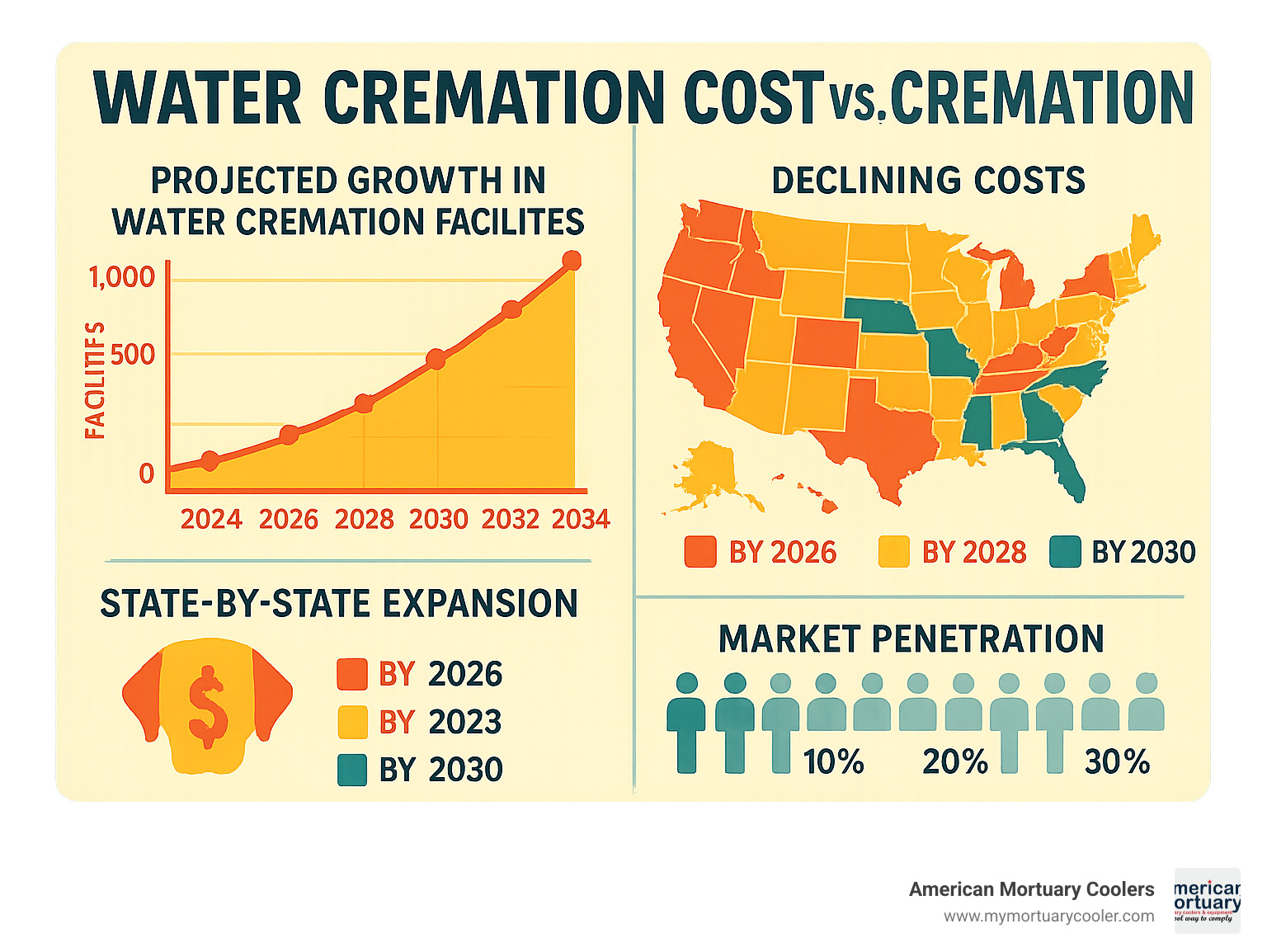
Ready to explore how aquamation equipment might fit into your facility's future? Learn more about aquamation equipment and essential supplies to find how we can support your expansion into water cremation services with solutions custom to your specific needs and budget.



